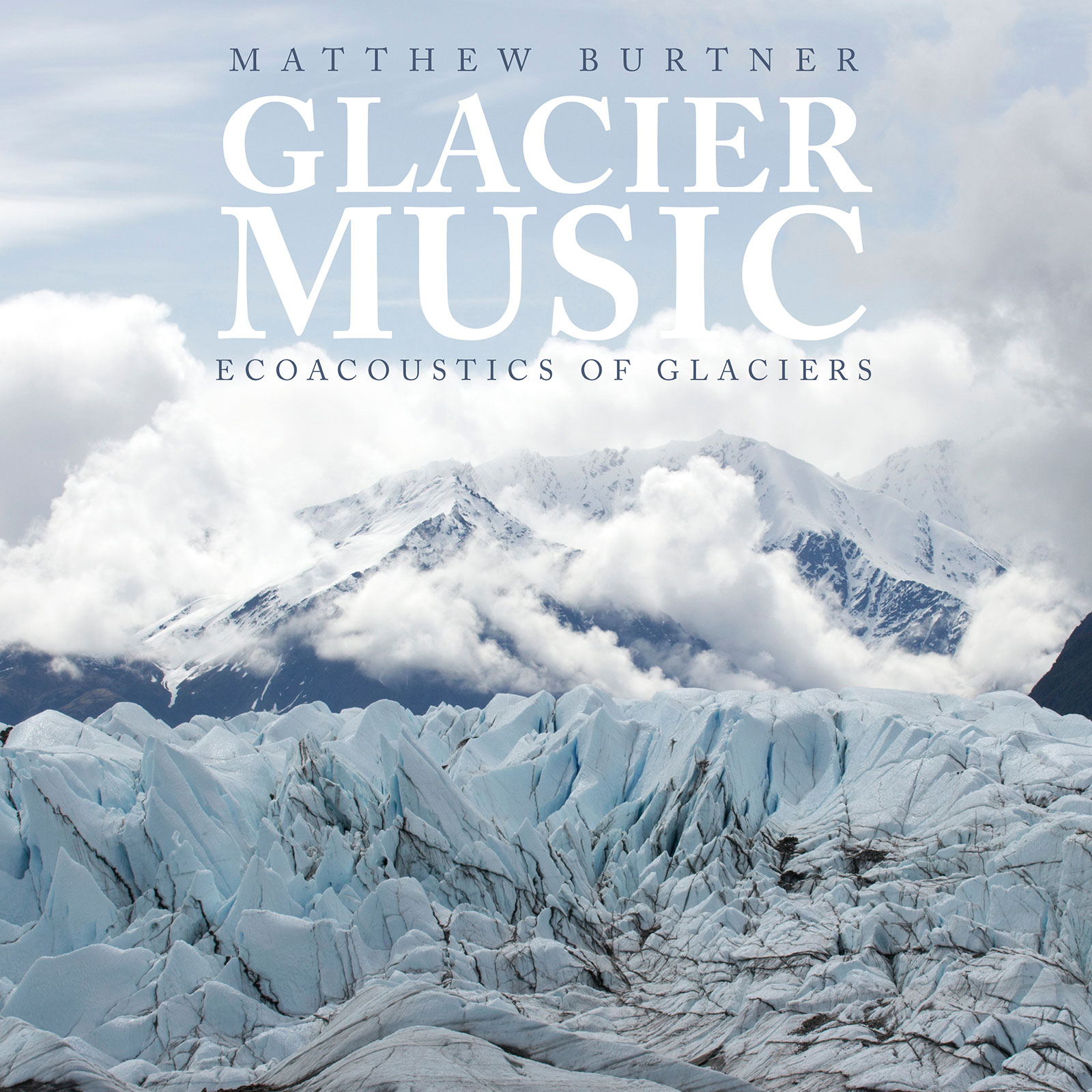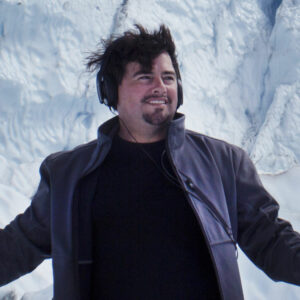
Share Album:
Glacier Music
Matthew Burtner composer
Rivanna Quartet
Albermarle Ensemble
Brandon Bell percussion
Trevor Saint percussion
Matthew Burtner returns to Ravello Records with the haunting beauty of GLACIER MUSIC, an electroacoustic collection featuring the Alaskan natural landscape as the central instrument. Most of the natural sounds were recorded on Alaskan glaciers, featuring the sounds of snow, trickling streams, and the cracks, pops, and thundering as glaciers break apart and fall. Burtner, who was born in Alaska and grew up among the glaciers, also sculpts scientific measurements of glacial melt into the music through a technique known as sonification.
Sound Cast of Matanuska Glacier, written upon request for President Obama’s 2015 GLACIER Conference, demonstrates the warning signal behavior of glaciers. Standing as the threshold between mountain and ocean, glaciers are highly sensitive to global warming, and their state indicates just how rapidly the globe is heating up. Sonic Physiography of a Time-Stretched Glacier also looks at the melting of an Alaskan glacier, but from a different perspective — Burtner applies time stretching with interactive software which slows, and eventually halts, the effects of climate change to the listening ear. Threnody was recorded on Aialik Glacier, part of the 23,000-year-old Harding Ice Field, and catches the sounds of ancient air being released from pockets inside the glacier as pieces break from the main ice and melt as they drift out to sea with the tide.
Syntax of Snow is formed from the unlikely duo of amplified snow and glockenspiel. The performers played the glockenspiel with one hand and the snow with the other, speaking to the snow’s ability to communicate information to people and animals about environment, weather conditions, and landscape. The album concludes with Muir Glacier, 1889-2009, perhaps the most romantic and haunting piece of all. The piece was commissioned by the Anchorage Museum of Art for the Alaska Gallery to accompany the Thomas Hill painting, Muir Glacier, 1889, which had depicted Muir Glacier in its fullness. Over a 120-year period, the glacier gradually shrank from the water, retreating up the valley until it vanished entirely in 2009. To recreate the experience, the composer recorded sounds from glaciers in various states of retreat, so that the piece follows a linear timeline from the healthy glacier’s beginnings to its ultimate demise.
GLACIER MUSIC captures the beauty of both sights and sounds in the natural landscape, while also emphasizing the bitter reality for many of its subjects. Burtner, poignantly depicts the precarious situation of these natural wonders, leaving listeners both awed and perhaps inspired to take action.
Listen
Stream/Buy
Choose your platform
Track Listing & Credits
| # | Title | Composer | Performer | |
|---|---|---|---|---|
| 01 | Sound Cast of Matanuska Glacier | Matthew Burtner | Rivanna Quartet | Daniel Sender, violin; David Sariti, violin; Ayn Balija, viola; Adam Carter, cello; Albermarle Ensemble | Kelly Sulick, flute; Shawn Earle, clarinet; Katy Ambrose, horn; Greg Howard, chapman stick | 23:18 |
| 02 | Sonic Physiography of a Time-stretched Glacier | Matthew Burtner | Brandon Bell, percussion | 10:56 |
| 03 | Threnody (Sikuigvik) | Matthew Burtner | 4:58 | |
| 04 | Syntax of Snow | Matthew Burtner | Trevor Saint, percussion | 8:54 |
| 05 | Muir Glacier, 1889-2009 | Matthew Burtner | 26:03 |
Compositions, field recordings and sonifications by Matthew Burtner
SOUND CAST OF MATANUSKA GLACIER
Recorded at Old Cabell Hall, University of Virginia in Charlottesville VA
Recorded on Matanuska Glacier in Alaska
Instrument Recording Engineer Travis Thatcher
Field Recording Engineer Matthew Burtner
SONIC PHYSIOGRAPHY OF A TIME-STRETCHED GLACIER
Recorded at Stude Hall, Rice University in Houston TX
Recorded on Root Glacier, Alaska
Recording Engineer Matthew Burtner
THRENODY (SIKUIGVIK)
Recorded on Ailik Glacier in Alaska
Field Recording Engineer Matthew Burtner
SYNTAX OF SNOW
Recorded at University of Wisconsin-Whitewater Recording Center,
University of Wisconsin-Whitewater in Whitewater WI
Recording Engineer Jeff Herriott
MUIR GLACIER, 1889-2009
Recorded on various Alaskan glaciers assembled to sonify the retreat of Muir Glacier over 130 years
Field Recording Engineer Matthew Burtner
This recording was made thanks to generous support from the University of Virginia Office of the Provost & the Vice Provost for the Arts, and from the College and Graduate School of Arts and Sciences.
Executive Producer Bob Lord
Executive A&R Sam Renshaw
A&R Marina Altschiller
Vice President, Audio Production Jeff LeRoy
Engineering Manager Lucas Paquette
Art Director Brett Picknell
Design Ryan Harrison, Edward A. Fleming
Publicity Scott Feldman, Patrick Niland
Artist Information

Matthew Burtner
Matthew Burtner is an Alaskan-born composer, sound artist, and eco-acoustician whose work explores embodiment, ecology, polytemporality, and noise. His music comfortably crosses boundaries between environmental science and art, philosophy and acoustics, technology and body, and he is a leading practitioner of climate change music and ecoacoustic sound art. As a composer, Burtner seeks out contexts where critical issues of human/nature interaction are addressed, whether in musical contexts, other forms of media, scientific conferences, or political conventions. His music has been performed in concerts around the world and featured by organizations such as NASA, PBS NewsHour, the American Geophysical Union (AGU), the BBC, the U.S. State Department under President Obama, and National Geographic.
